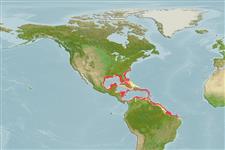Gastropoda |
Trochida |
Turbinidae
Environment: milieu / climate zone / depth range / distribution range
Ecology
Benthic; depth range 0 - 141 m (Ref. 109264). Tropical; 35°N - 4°S, 94°E - 38°E (Ref. 83435)
Western Atlantic.
Length at first maturity / Size / Weight / Age
Maturity: Lm ? range ? - ? cm Max length : 5.0 cm DL male/unsexed; (Ref. 83435); common length : 3.8 cm TL male/unsexed; (Ref. 355)
Shell turbinate. Sculpture of spiral rows of beads, sometimes with small spines on whorl shoulders. Colour: tan to light brown, with patches of brown, reddish brown, and cream.
On sand and shell and coral rubble, in shallow subtidal (Ref. 355). Found in seagrass, ascidian, and algae habitats (Ref. 83934). Also known from seamounts and knolls (Ref. 3477).
Life cycle and mating behavior
Maturity | Reproduction | Spawning | Eggs | Fecundity | Larvae
Members of the order Patellogastropoda are mostly gonochoric and broadcast spawners. Life cycle: Embryos develop into planktonic trocophore larvae and later into juvenile veligers before becoming fully grown adults.
Leal, J.H. 2003 Gastropods. p. 99-147. In Carpenter, K.E. (ed.). The living marine resources of the Western Central Atlantic. Volume 1: Introduction, molluscs, crustaceans, hagfishes, sharks, batoid fishes, and chimaeras. FAO Species Identification Guide for Fishery Purposes and American Society of Ichthyologists and Herpetologists Special Publication No. 5. 1600p. (Ref. 355)
IUCN Red List Status
(Ref. 130435: Version 2025-1)
CITES status (Ref. 108899)
Not Evaluated
Not Evaluated
Threat to humans
Human uses
Fisheries: commercial
| FishSource |
Tools
More information
Trophic EcologyFood items (preys)
Diet composition
Food consumption
Predators
Population dynamicsGrowth
Max. ages / sizes
Length-weight rel.
Length-length rel.
Length-frequencies
Mass conversion
Abundance
Life cycleReproductionMaturityFecunditySpawningEggsEgg developmentLarvae PhysiologyOxygen consumption
Human RelatedStamps, coins, misc.
Internet sources
Estimates based on models
Preferred temperature
(Ref.
115969): 23.5 - 28, mean 26.2 (based on 294 cells).
Fishing Vulnerability
Low vulnerability (10 of 100).
